Day 11 - Thursday 9/22/05
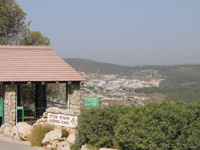
|
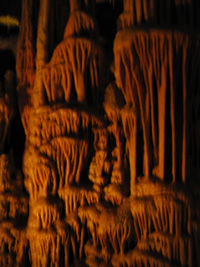
|
Soreq Stalactite Cave
Our first stop of the day was the Soreq Stalactite Cave in the Judean Hills. The cave was discovered accidentally by workers blasting at a nearby quarry and is unique in that prior to the blast, it had no external openings, making it pristine and untouched (undamaged) by human hands. Since my last visit here at the age of around nine when the cave had just been made accessible to the public, many improvements have been made including an informative movie on the formation of the cave, an elaborate lighting system, and a wooden railed walkway. From that earlier visit, I distinctly remember the poignant story of the Romeo and Juliet stalactite and stalagmite whose ends were only 1 mm apart and would never meet as they were in an inactive portion of the cave and had ceased to grow. On this visit, I was happy to hear that that portion of the cave had became active again last year and the love story now has a chance at a happy conclusion.
We returned to western Jerusalem in order to spend the afternoon viewing the Shrine of the Book and the Israel Museum.
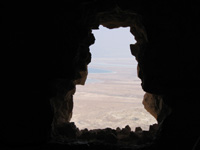
Shrine of the Book
The Shrine of the Book is the repository of one of the most exceptional archaeological finds in the Middle East - the Dead Sea Scrolls, which are on display along with the Aleppo Codex. As the fragility of the scrolls makes it impossible to display them all on a continuous basis, a system of scroll rotation is used. After a scroll has been exhibited for 3-6 months, it is removed from its showcase and placed temporarily in a special storeroom, where it "rests" from exposure. The shrine is built as a white dome covering a structure that is two-thirds below the ground, and is reflected in a pool of water that surrounds it. Across from the white dome is a black basalt wall. We had an incredible two-hour tour with an English speaking guide who really brought to life the people and culture of the sect of Qumran who wrote the scrolls, the story of the discovery of the scrolls, and the contents of the scrolls themselves. In short, a group of religious men during the Second Temple period left Jerusalem and established a community at Qumran in the desert on the northern shore of the Dead Sea in order to freely practice their form of religion which was stricter than that observed in the Temple. When the Jews revolted against Roman rule in 66 CE, these people hid their library in caves in the desert. In 1947, Bedouin shepherds discovered the first cave containing four scrolls, and through 1956, 11 caves were located containing roughly 850 documents written between the 2nd century BCE and the 1st century CE. About 30% are fragments from the Hebrew Bible, from all the books except the Book of Esther. About 25% are traditional Jewish religious texts that are not in the canonical Hebrew Bible. Another 30% contain Biblical commentaries or other texts such as the "Manuel of Discipline or "Community Rule" and the "Rule of War" related to the beliefs, regulations, and membership requirements of the sect believed to have lived in Qumran. The texts are of great significance in a religious context, as they are the oldest known copies of the Hebrew Bible.
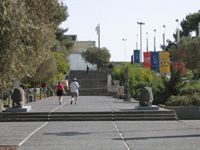
Israel Museum
At the Israel Museum, we explored the departments of Archaeology & Antiquities from prehistory to the present. There were also informative displays on the history of Hebrew script and on glassmaking through the ages.
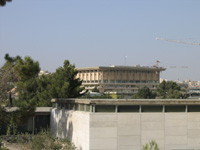
The Knesset
On our way out of town we had a good view of the Knesset, the Israeli Parliament building. After feeding our minds for so many hours, it was time to feed our bodies with another stop in Abu-Ghosh for falafel on the way home.
<<--- Yesterday |
Tomorrow --->> |
| Copyright © 2005 by Oreet Herbst and John Knott |